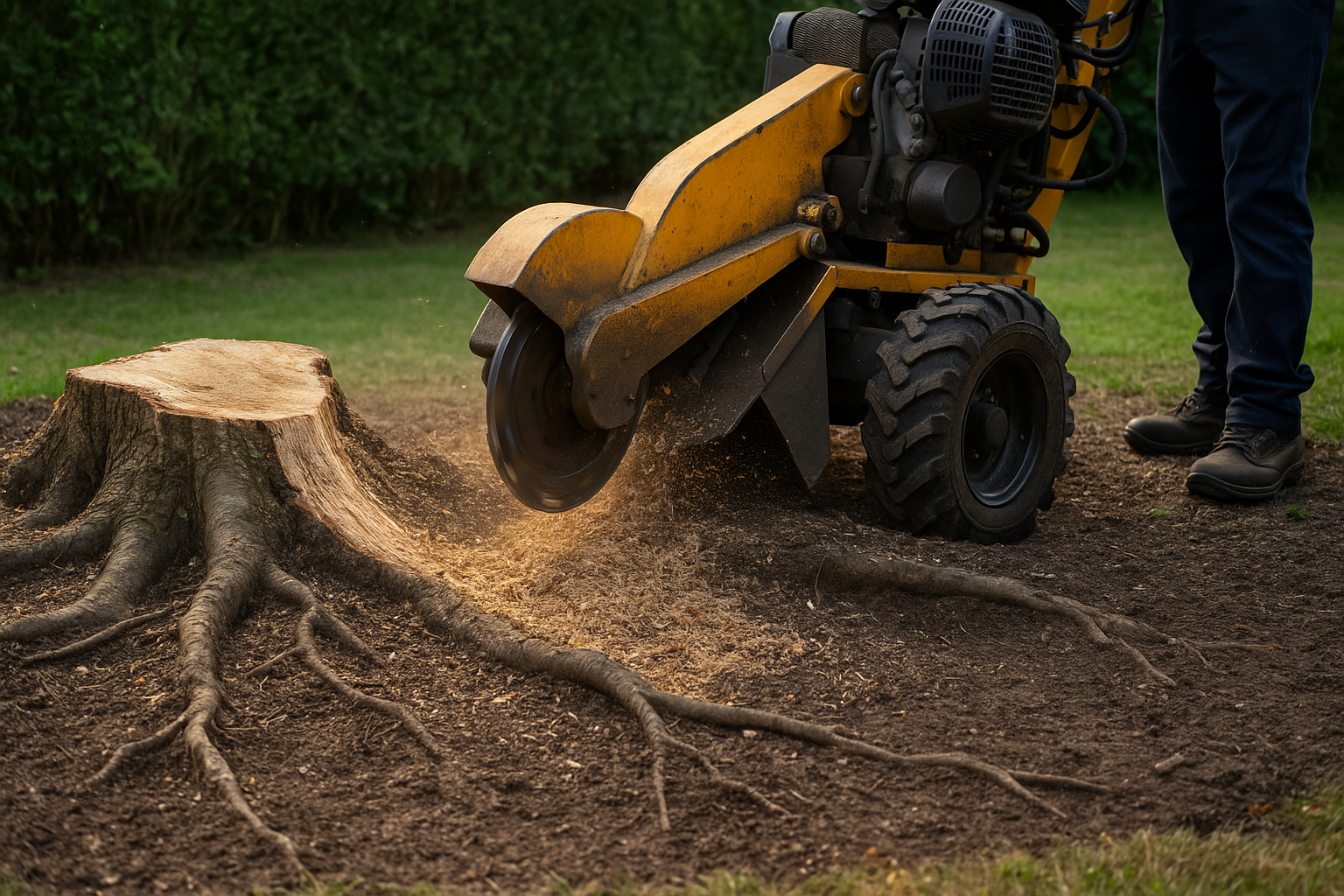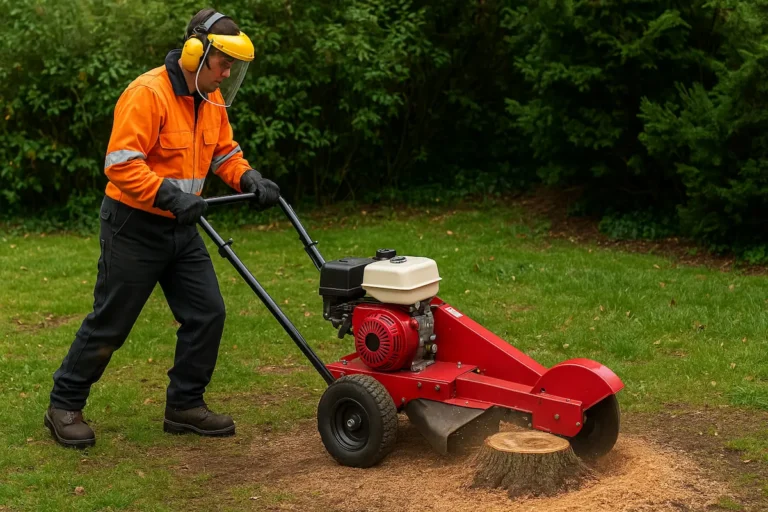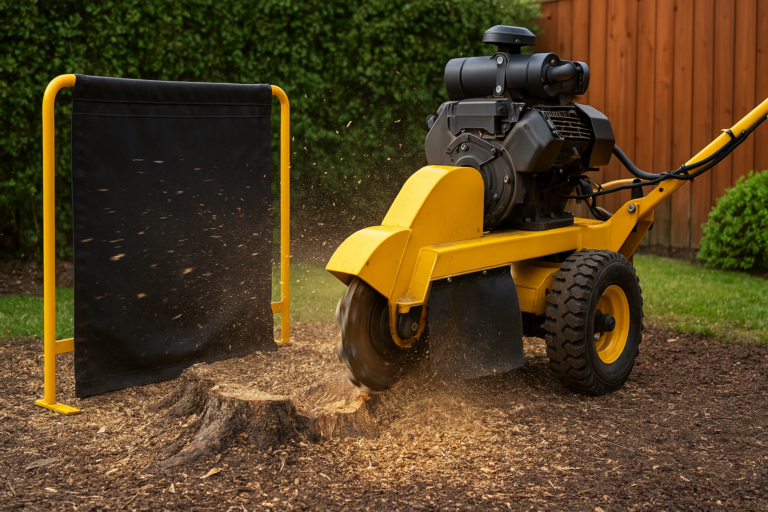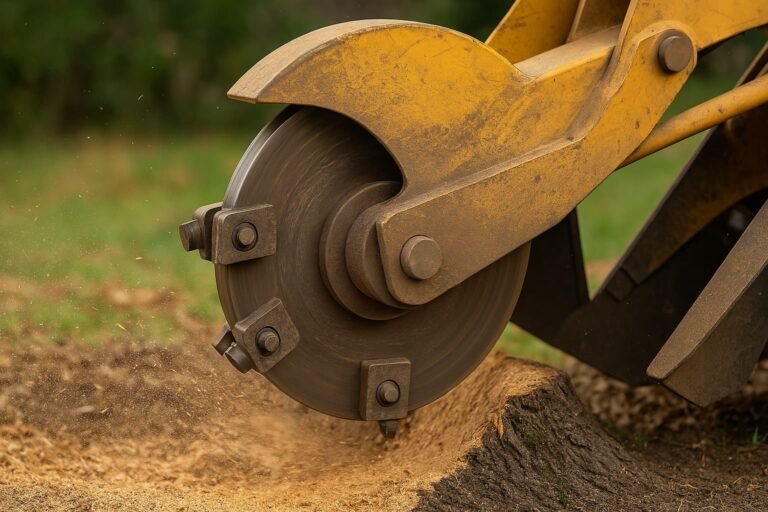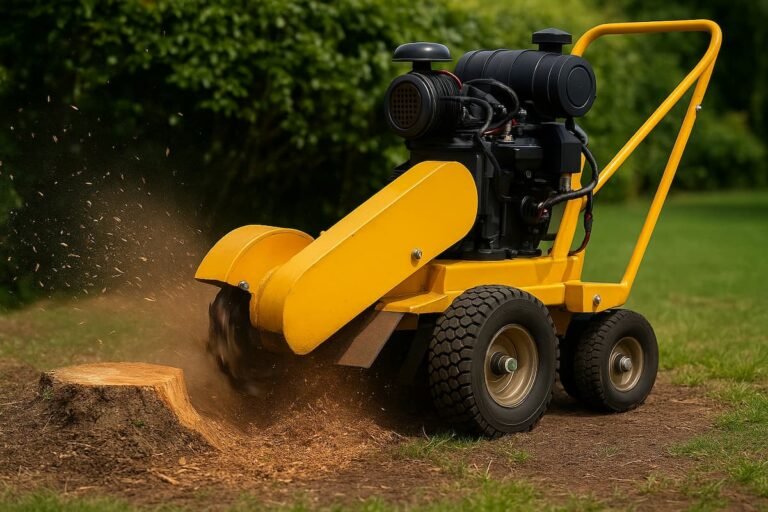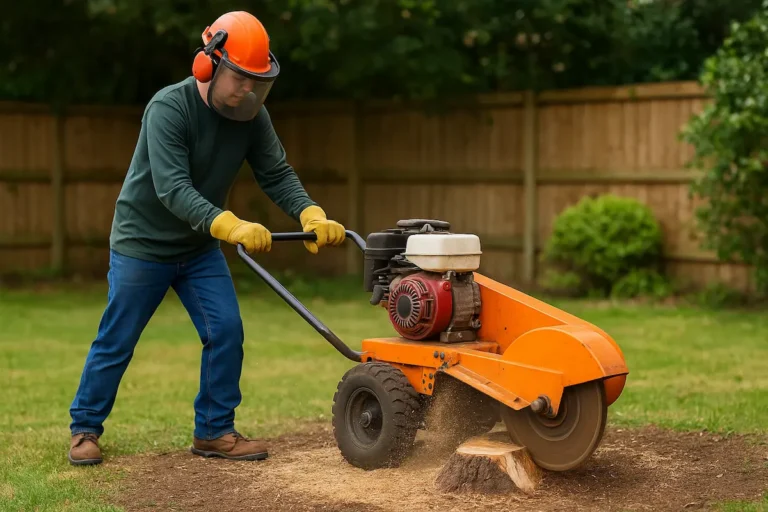Root Cutting and Stump Grinding: Your Complete UK Guide
Got an ugly tree stump?
Are you worried about the roots left behind?
Good news. Stump grinders do cut tree roots.
This guide shows you how it works for UK gardens.
It explains what our stump grinding service covers.
Stump Grinding Depth & Root Removal
Key Takeaways:
- Standard Grinding (15-30 cm deep): Effectively removes the main stump body and root crown, suitable for laying turf or grass seed. It kills the stump, preventing easy regrowth.
- Deep Grinding (30-45+ cm deep): Reaches further down to remove more of the central root system. This is often necessary if you plan to replant a new tree or shrub in the same spot.
- Root Focus: Both methods target the main stump and the large roots immediately attached (root flare), but deeper grinding removes a larger portion of the core root structure below ground.
- Effectiveness: Stump grinders efficiently turn both stump wood and attached roots into mulch, addressing the core issue directly below the surface.
Yes, Stump Grinders Effectively Cut Tree Roots
You asked if stump grinders can cut tree roots.
The answer is definitely yes.
Stump grinders are powerful machines.
They have strong, sharp teeth on a spinning wheel.
These teeth chip away at wood very fast.
They work just as well on tree roots near the stump.
The grinder doesn’t know the difference between stump wood and root wood.
It turns both into small wood chips (mulch).
So, grinding a stump also grinds the roots attached to it.
How We Grind Stumps and Roots: The Process Explained
Understanding the process helps you know what to expect.
Our trained operators follow clear steps.
They ensure the job is done safely and correctly.
Initial Stump Attack
First, we bring the grinder to the stump.
We position the spinning cutting wheel over the stump top.
The operator carefully lowers the wheel into the wood.
They move the wheel side-to-side.
This action chips away the main stump body.
We work downwards, layer by layer.
Chasing the Root Flare
The root flare is where the stump joins the primary roots.
This area is often broad and thick.
It needs careful grinding.
We grind this flare thoroughly.
This breaks the connection between the stump and large roots.
It helps remove the core root structure just below the surface.
Grinding Below Ground Level
We don’t just grind the visible stump.
We grind down into the soil.
Our standard depth is usually 15-30 centimetres (6-12 inches) below ground level.
This removes the central part of the stump hidden underground.
It also gets rid of the top section of the primary roots.
“They ground the stump right down. I couldn’t tell where it had been!” – Satisfied Customer Quote.
What Remains? Mulch and Soil Mix
After grinding, you don’t have a solid stump anymore.
You have a hole filled with a mixture.
This mix contains small wood chips, root bits, and soil.
We call this mixture mulch or grindings.
It can be used elsewhere in the garden or removed.
It shows the grinder has broken down the stump and roots.
Understanding Different Tree Root Types We Encounter
Trees have different kinds of roots.
Knowing them helps us understand how we grind.
- Buttress Roots: These are large roots flaring out at the stump base. They look like supports. Grinders easily chew through these as part of the central stump.
- Lateral Roots: These roots spread sideways, usually just below the soil surface. They can travel far. Grinders remove the parts closest to the stump.
- Surface Roots: These are lateral roots that stick out above the ground. They can be trip hazards or damage lawnmowers. We can grind these, too (more on this later).
- Tap Roots: Some trees have a primary root going straight down. Grinding depth affects how much of this we remove.
Our machines handle all these root types near the stump.
The main difference is how far out lateral or surface roots spread.
How Deep Do Stump Grinders Cut Roots?
The depth we grind affects how much root we remove.
We offer different options based on your needs.
Standard Depth Grinding:
- Typically 15-30 cm (6-12 inches) below the surface.
- This removes the main stump body and the root crown.
- It kills the stump and stops easy regrowth.
- It’s usually enough to lay turf or grass seed over the area.
- It gets rid of the central root mass directly under the stump.
Deep Grinding:
- It can go 30-45 cm (12-18 inches) or even deeper.
- Removes more of the central root system.
- It is often needed if you plan to replant a new tree or large shrub.
- It is better for completely breaking up the core root structure.
- It costs a bit more as it takes longer.
Table: Grinding Depth and Root Removal
| Grinding Depth | Level Below Ground | Root Removal Focus | Good For… |
|---|---|---|---|
| Standard | 15-30 cm (6-12 in) | Stump body, Root crown, Upper roots | Laying turf, Levelling area |
| Deep | 30-45+ cm (12-18+ in) | Deeper central roots, More root mass | Replanting trees/shrubs, Foundations |
We discuss the correct depth with you before starting.
What Root Cutting is Included in Standard Stump Grinding?
This is a ubiquitous question.
People want to know precisely what they get.
Our standard stump grinding service typically includes the following:
- Grinding the main stump body.
- Grinding down to the standard depth (15-30 cm).
- Grinding the main root flare where roots join the stump.
- Grinding visible roots immediately around the stump. This usually means roots within about 1 metre (3 feet) of the stump edge.
What’s usually not included in the standard price:
- Chasing down long surface roots far across the garden.
- Grinding roots very close to delicate structures without discussion.
- Removing the mulch/grindings from the site (this is often an extra service).
We are always clear about what the quote covers.
There are no hidden surprises about root cutting.
Tackling Problematic Surface Roots: Our Approach
Surface roots are a significant pain for many homeowners.
They trip people up.
They damage lawnmowers.
They make the garden look messy.
Assessing Surface Roots
When we quote, we look for surface roots.
We check how long they are.
We see how far they spread from the central stump.
We note their location (near paths, pipes, etc.).
This helps us plan the best way to deal with them.
Grinding Visible Surface Roots
Yes, we can grind these surface roots.
Our machines can carefully chip them away.
This levels the ground nicely.
It makes the area safe again.
It stops lawnmower damage.
“The big surface roots from our old oak were a nightmare. They ground them down completely. Now the kids can play safely, and mowing is easy!” – Local Customer Testimonial.
Discussing Your Options for Distant Roots
Sometimes, surface roots spread very far from the stump.
Grinding roots 10 metres across your lawn takes extra time.
It might need a smaller, more manoeuvrable machine.
We will discuss this with you.
Grinding distant surface roots might cost extra.
We will explain the time and cost involved.
You can then decide how much root chasing you want.
We want to solve your problem effectively and fairly.
Will Stump Grinding Stop Tree Roots Regrowing?
Nobody wants a tree trying to grow back!
Stump grinding is very effective at stopping this.
Removing the Energy Source
A tree stump is like the control centre for the roots.
It stores food and helps roots get water.
Grinding the stump removes this control centre.
It also grinds the root crown, the vital connection point.
Without the stump, the roots can’t get what they need to live.
Most roots will then die off and rot away naturally underground.
This process usually takes several months to a year or two.
Which Trees Might Sprout Again?
Some trees are known for being very persistent.
Even after grinding, small sprouts (suckers) might appear from leftover roots far from the stump.
Common persistent trees in the UK include:
- Popular
- Willow
- Robinia (False Acacia)
- Tree of Heaven
- Lilac (though technically a shrub, often has persistent roots)
Good News: Stump grinding massively reduces the chance of regrowth, even for these trees.
Removing the central stump takes away 95%+ of the energy source.
Any suckers that do appear are usually weak.
They can often be easily cut off or treated.
The Importance of Grinding the Root Crown Thoroughly
This is key to stopping regrowth.
We grind the entire flare where the stump meets the roots.
This completely severs the connection.
It’s much more effective than grinding the stump’s top part.
Fact: Thorough stump and root crown grinding is the best mechanical method to prevent regrowth.
Safely Grinding Roots Near Pipes, Paths, and Foundations
Roots can grow near essential things.
You might worry about damage during grinding.
Safety is our top priority.
Identifying Underground Utilities:
- Before we grind, we ask about known utilities.
- Things like water pipes, gas lines, electric cables, or drains.
- We encourage homeowners to check plans if unsure.
- Reputable services often perform utility checks (like using CAT scanners) in sensitive areas.
Careful Operation:
- Our operators are trained and experienced.
- They control the grinder precisely.
- They can carefully grind roots near structures without damaging them.
- They adjust the grinding depth and angle as needed.
- We communicate with you about any sensitive areas.
Case Study Snippet:
“We had a large conifer stump next to our garden wall. The grinder operator was brilliant. He removed the stump and nearby roots without leaving a mark on the wall.”
We take care to protect your property while removing the problem roots.
Our Stump Grinding Equipment: Powering Through Roots
We use professional stump grinders.
These machines are built for the job.
Different Sizes for Different Jobs:
- Small Grinders: Good for tight spaces or small stumps. It can fit through garden gates. It’s still powerful enough for many roots.
- Medium-tracked grinders Offer more power and stability. They are great for medium to large stumps and tackling tougher roots. The tracks help on slopes or soft ground.
- Large Hydraulic Grinders are the most powerful machines. They are ideal for huge stumps and extensive root systems, making quick work of big jobs.
How They Cut Roots:
- The carbide teeth are extremely hard.
- They spin at high speed.
- They chip away wood and roots effectively.
- They work below ground level efficiently.
Our machines power through tough wood and big roots.
We choose the right machine for your specific stump and root situation.
This ensures efficiency and a great result.
Why Grinding Tree Roots is Essential After Stump Removal
Just cutting down the tree isn’t the end of the story.
Leaving the stump and its roots causes problems.
Grinding them offers many benefits.
Eliminating Tripping Hazards
- Stumps and surface roots are dangerous trip hazards.
- It is hazardous for children and older people.
- Grinding removes the stump, and levels surface roots.
- It makes your garden safe again.
Preventing Damage
- Roots keep growing for a while, even after the tree is cut.
- They can crack paths, patios, driveways, and walls.
- Surface roots damage lawnmowers.
- Grinding stops this ongoing damage.
Preparing for Future Landscaping
- You can’t easily build or plant over a stump.
- Grinding creates a clear, level area.
- Perfect for laying a new lawn.
- Ideal for creating a patio or flower bed.
- Allows replanting (especially after deep grinding).
Reducing Pest Attraction
- Old stumps and decaying roots attract insects.
- Pests like termites, beetles, and ants love rotting wood.
- They can sometimes spread to your home.
- Grinding removes the rotting wood source.
- It helps keep unwanted pests away.
Common Root Problems & How Grinding Solves Them
- Problem: Big roots lifting paving slabs.
- Solution: Grinding removes the root section of the problem near the path.
- Problem: Surface roots making mowing impossible.
- Solution: Grinding levels the roots below the surface.
- Problem: Worrying about roots near house foundations.
- Solution: Grinding the stump removes the primary energy source, causing nearby roots to decay. (Note: Grinding directly beside foundations needs expert assessment).
- Problem: Old stump resprouting annoying shoots.
- Solution: Thorough grinding of the stump and root crown stops regrowth.
Stump Grinding vs. Digging Out Roots: Why Grinding is Better
You might wonder about digging roots out by hand.
Or using a big digger (excavator).
Here’s why grinding is usually the best choice:
Table: Grinding vs. Digging
| Feature | Stump Grinding | Digging Out (Manual or Excavator) |
|---|---|---|
| Process | Chips wood & roots into small mulch | Pulls out large, dirty root pieces |
| Disruption | Minimal ground disturbance around hole | Creates a large hole, disturbs wide area |
| Waste | Produces usable mulch | Leaves large roots/stump to dispose of |
| Time | Fast, efficient (usually hours) | Very slow (manual) or needs large machine |
| Cost | Often more cost-effective | Can be expensive (labour/machine hire) |
| Result | Neat hole, level area possible immediately | Big messy hole, needs lots of backfill |
| Root Removal | Excellent for stump & nearby roots below grade | Can remove more distant roots, but messy |
Grinding is faster and much tidier.
It targets the stump and primary roots effectively.
It leaves usable mulch instead of big lumps of wood.
It causes less damage to the surrounding garden.
Grinding is the preferred method for most homeowners.
See the Results: Root Cutting Case Studies & Examples
Real examples show how well grinding works on roots.
Example 1: Oak Stump with Surface Roots
- Problem: A large oak stump left big surface roots cracking a patio. Mowing was difficult.
- Action: We ground the stump deep (30cm). We then chased the primary surface roots by 2 metres, grinding them below lawn level.
- Result: The patio area is safe. The lawn is level and easy to mow. The client was thrilled.
Example 2: Willow Stump Regrowth Concern
- Problem: The homeowner worried a felled willow would regrow from the roots. The stump was near a fence.
- Action: We thoroughly ground the willow stump and root crown to standard depth. We paid extra attention near the fence.
- Result: No regrowth seen after 1 year. Fence undamaged. Area ready for new planting. “I was worried Willow would return, but the grinding worked perfectly!”
Example 3: Multiple Conifer Stumps
- Problem: A row of conifer stumps with intertwined roots needed removing for a new driveway extension.
- Action: A powerful tracked grinder tackled all stumps and the central root mass connecting them. Ground to 25cm depth.
- Result: The area cleared quickly and efficiently. Ready for the driveway preparation work the next day. Estimated time saving vs digging: 2 days.
These examples show we handle various root challenges.
Frequently Asked Questions About Root Cutting and Grinding
Here are answers to common questions we hear.
- Can your grinders handle extensive roots? Yes, our professional grinders have powerful engines and sharp teeth. They cut through large buttress roots and thick lateral roots connected to the stump.
- How much extra does grinding surface roots far from the stump cost? It depends on how far the roots spread and how many there are. It takes additional time. We assess this during the quote and provide a clear price for any extra root chasing you want to be done.
- Will grinding harm nearby plants or trees? We are cautious. Grinding is relatively localised. It generally doesn’t harm plants a few feet away. If grinding near delicate plants or roots of trees you want to keep; we will discuss precautions with you.
- What happens to the roots left deeper in the ground? Roots far from the stump, or deeper than we grind, lose their energy source. They will slowly die and decompose naturally in the soil over time. They usually don’t cause problems.
- Do I need to do anything before you arrive to grind roots? Please clear the area around the stump. Remove any stones, garden ornaments, toys, or debris. Knowing the location of any underground pipes or cables is also very helpful.
Ready to Remove Your Stump and Troublesome Roots?
Don’t let an old stump and its roots spoil your garden.
Stump grinding is a fast, effective, and clean solution.
It tackles the stump and problem roots together.
It leaves your garden safe, tidy, and ready for use.
Get Your Free, No-Obligation Quote Today
Check out our listings to find the right machine for your needs.
Our hire options include machines capable of cutting through tough roots.

